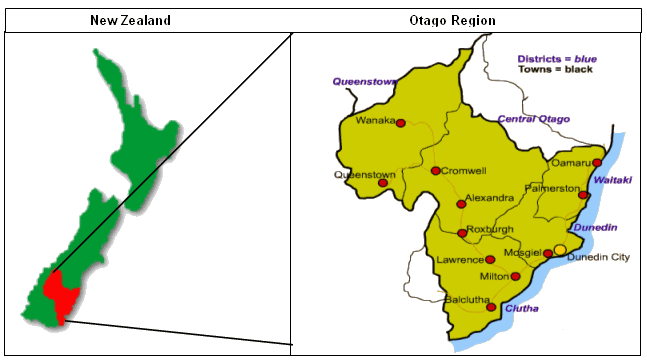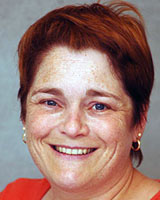Dear Editor
We would like to draw your readers' attention to an innovation information and communications technology project from the Otago region of New Zealand. The School of Nursing and School of Midwifery at Otago Polytechnic, Dunedin, New Zealand saw potential to work with an existing local organisation (OtagoNet) that was using video conferencing for high school educational purposes within the rural Otago region. With the equipment and infrastructures already established as part of the OtagoNet project, an ideal opportunity was provided to pilot educational and professional support among rural nurses and midwives within this region (Fig 1).
OtagoNet is an innovation information and communications technology project, based around the concept of video conferencing.

Figure 1: Otago regional map
Our aim was to provide nurses and midwives with access to regional technology, in this case video conferencing, and pilot a number of ways these practitioners could maintain and improve their professional competencies. Maintaining competencies are all the more challenging for practitioners in rural areas (because of geographical isolation) and methods of increasing the efficiency of this process are continually being sought. The video conference allowed rural practitioners to use different and varied forms of discussing practice with their peers (such as peer review sessions, case reviews, supervision, discussion, and journals clubs), undertaken at a distance. Each conference was structured so that the 'topical issue' was introduced and a brief background given before the video conference was opened up for discussion. Discussion occurred voluntarily among participants from each centre, with minimal stimulation and prompting needed.
Impressions/observations by facilitators and participants
The use of video conferencing appeared to overcome the isolation barrier by connecting rural practitioners and building a network within the region that each practitioner feels a part of. Feedback from the participants was positive about the concept of the video conference providing education and networking for people who are geographically isolated. Video conference provided face-to-face contact, and that was valued over other forms of interaction, such as by telephone, email or the internet. The participants had some criticism about working the equipment and the format, recommending greater support from knowledgeable technicians. They also felt it was important for the person leading the session to be skilled at video conference facilitation. All respondents commented they would participate in video conferencing in the future.
Through retrospective evaluation of the initial pilot along with further formal research, a greater understanding of the concept and effects will be gained. Video conferencing for rural practitioners has exciting potential to build relationships and minimize the main barrier of geographical personal and professional isolation. We believe that this pilot has improved collaboration with the rural high schools and facilitated the building of relationships within rural communities. This technology can be used as a way of building a bridge from a small rural community to the technology-orientated world.
We suggest that communication among people at a physical distance from each other is not compromised but made dynamic and effective by using this technology. Rural practitioners can then develop a relationship with other colleagues (at a distance) for networking, personal and professional support and ongoing development. We are committed to offer and provide ongoing development and access to this technology for rural practitioners. This commitment will maintain the ongoing relationship developed between institutions and rural communities and, in the long run, support the credibility of relationships.
Jean Ross, MA(Nsg)
Otago Polytechnic, School of Nursing, PO Box 1910, Dunedin, New Zealand
Sarah Stewart, MA
Otago Polytechnic, School of Midwifery, PO Box 1910, Dunedin, New Zealand
Howard Baldwin, MA
East Otago High School, Otago, New Zealand


